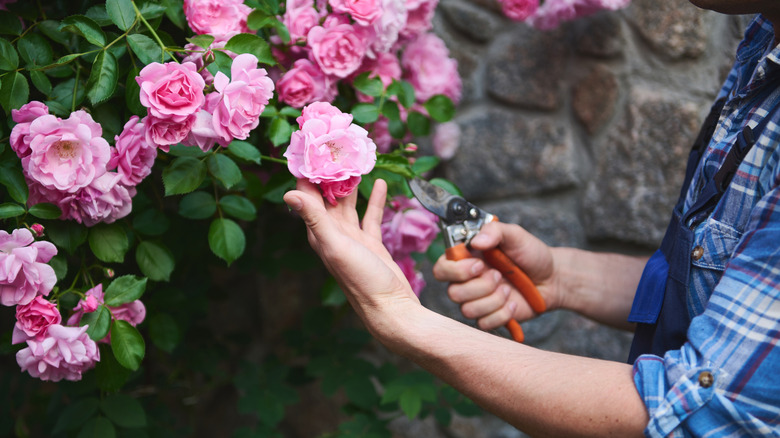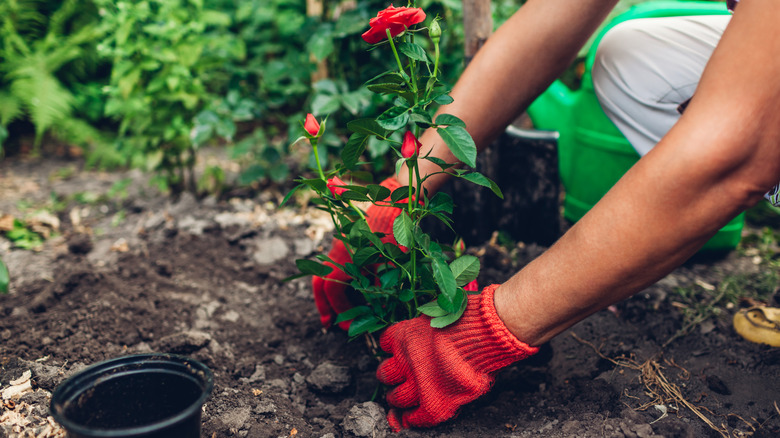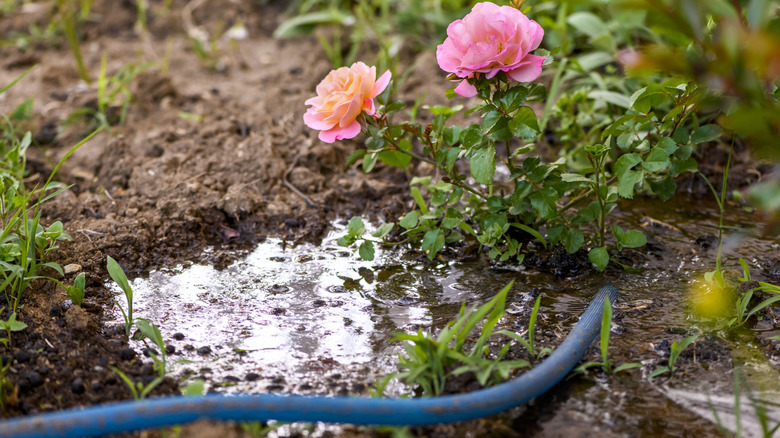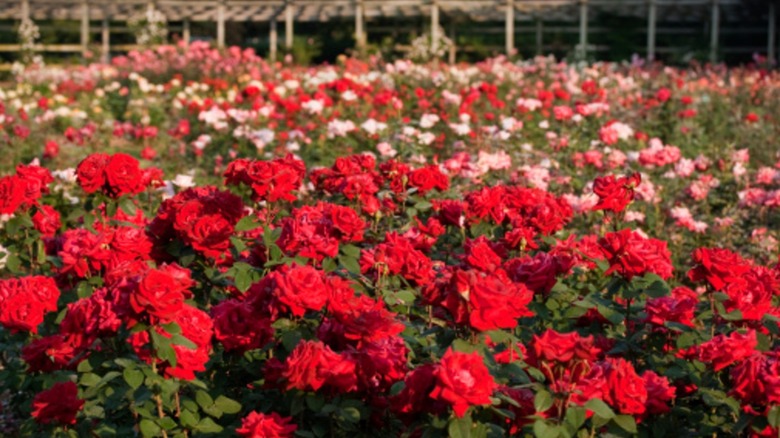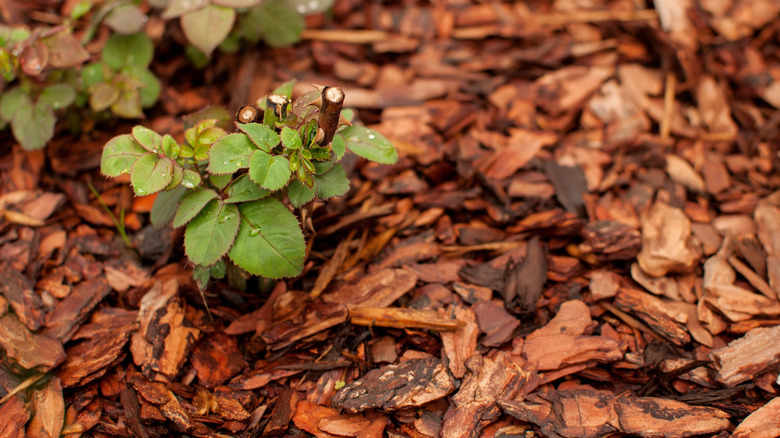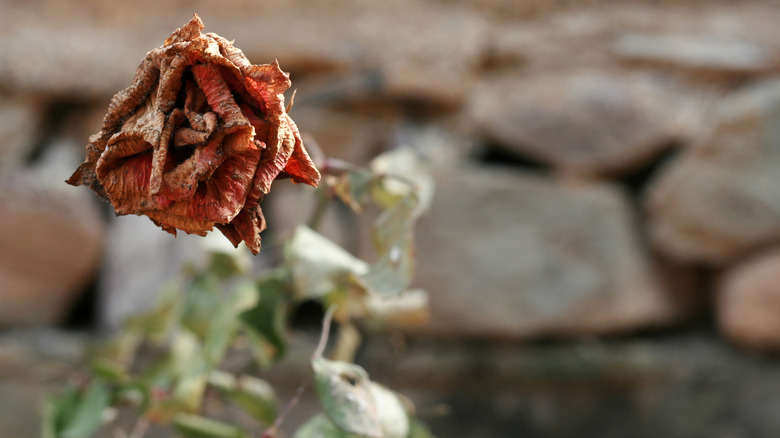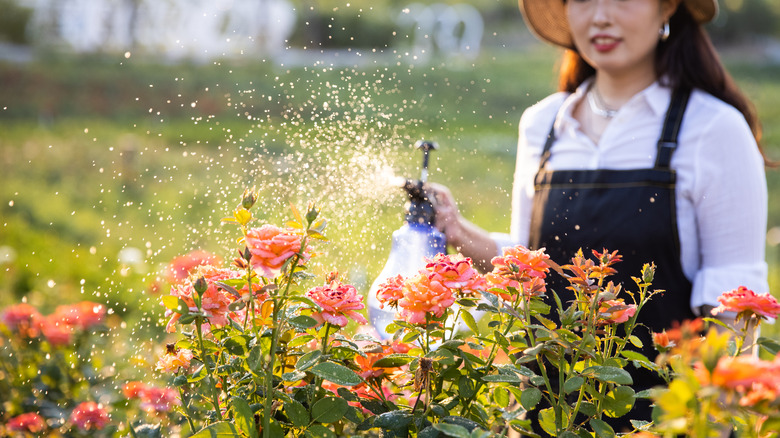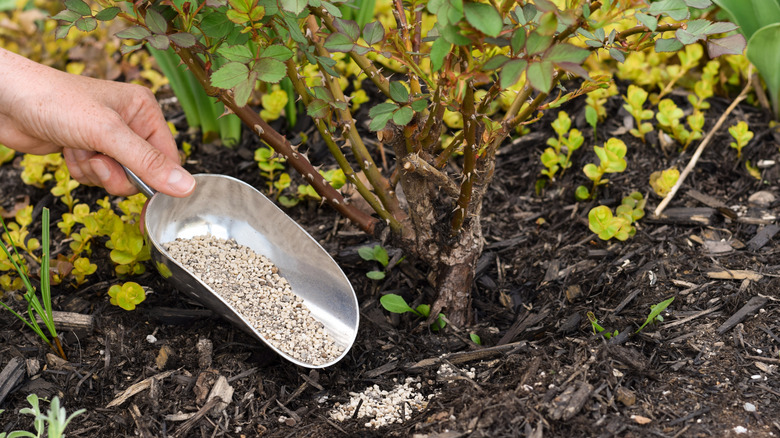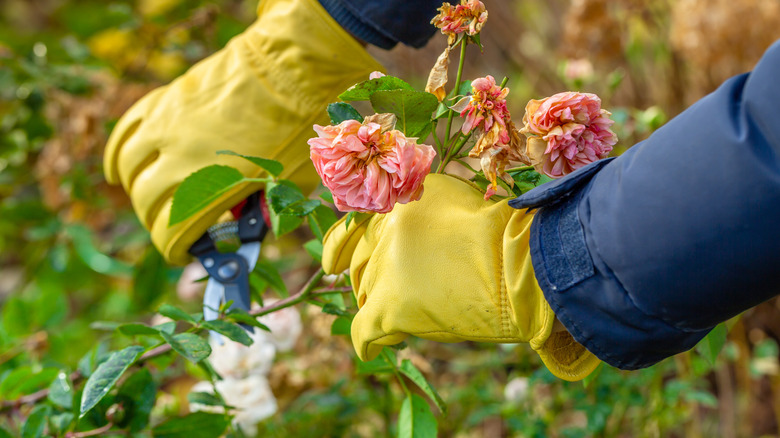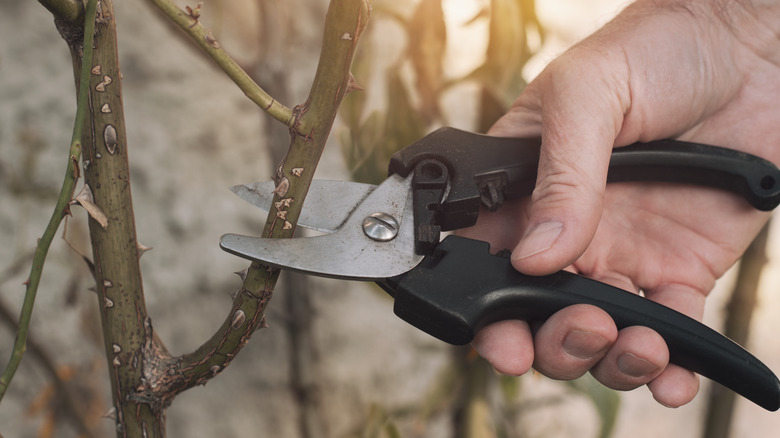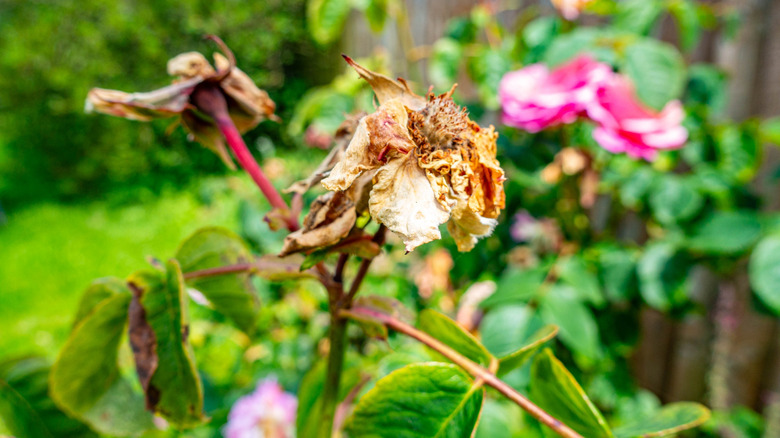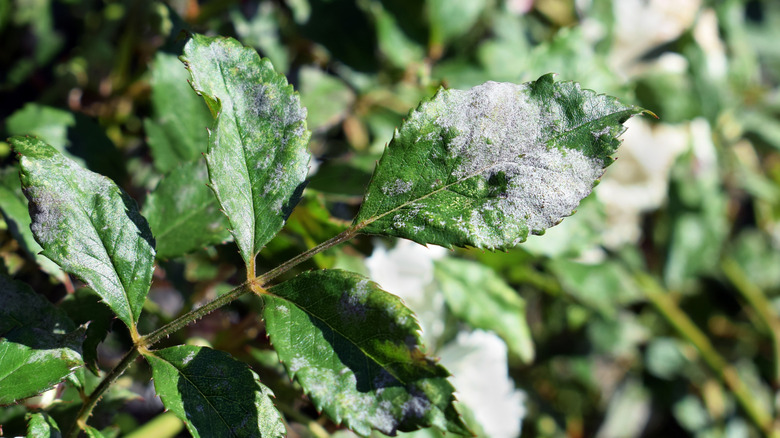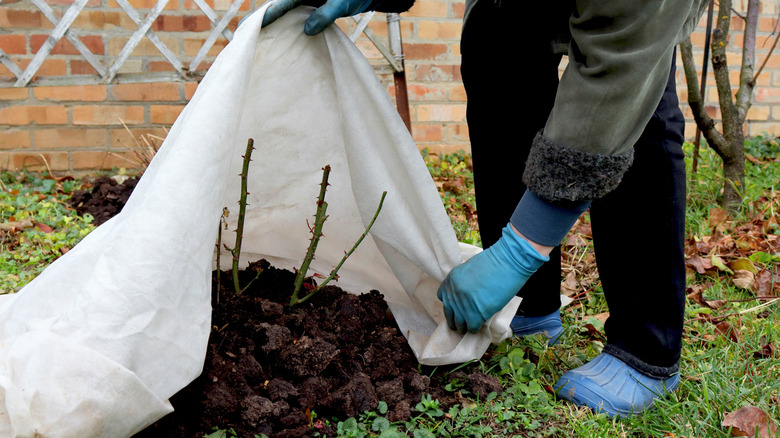Gardening Mistakes To Avoid To Get More Blooms From Your Roses
We may receive a commission on purchases made from links.
Thanks to crossbreeding, modern-day gardeners now have a wide variety of roses to choose from, each suited to different needs. Some varieties work well as accent plants, ground covers, screens, foundation plants, and sound barriers. There are also types designed to thrive in various growth zones and resist common diseases. Essentially, there is a rose for every outdoor situation! Plus, the stems can be trimmed to fill vases and bring a pop of natural color indoors.
That said, all the effort in choosing and planting your rose bushes could be wasted if they fail to bloom. Since these queens of flowers are quite the garden divas, they're quick to misbehave when gardeners make the smallest errors. Inadequate sun exposure, poor drainage, over-fertilization, incorrect pruning, and overwatering are common gardening mistakes you must avoid to enjoy abundant rose blooms.
Choosing the wrong rose variety
Scouring nursery catalogs for new pink rose varieties to make a blushing garden might be your favorite yearly ritual. However, if your goal is to get as many blooms as possible per season, make sure you buy the right variety — not all rose species are repeat bloomers. For instance, once- or twice-blooming varieties, such as pink Carolina roses (Rosa Carolina) or blush Damask roses (Rosa damascena) won't bloom every few weeks like some modern hybrid roses, no matter how hard you try.
To ensure you get as many blossoms as possible, you should also make sure you select a rose variety that's hardy to your zone and compatible with your yard's soil. This can help you determine if you need a variety that needs well-draining soil or one that can tolerate a wide range of ground conditions.
Another mistake to avoid while choosing plants is ignoring their maintenance levels. Many modern and hybrid rose varieties are high maintenance, and if you don't meet their constant watering, fertilizing, and pruning demands, you'll lose out on precious blooms. If you don't want to dedicate a ton of time to gardening, growing low-maintenance cultivars, like Bermuda, Bourbon, and Double Knock-Out makes more sense.
Planting roses in the wrong location
What makes roses such difficult plants to grow in the garden is that they're nit-picky about their location. So, when you make the mistake of placing them in low light conditions, they'll offer a poor flower display. While certain rose varieties tolerate partial shade, including some climbing roses, others require six to eight hours of direct sunlight. If this need is unmet, the shade will raise their susceptibility to powdery mildew and thrips, worsening their bloom quality. That's also why roses don't make good understory plantations for trees, as over time the expanding canopies overshadow their foliage, impeding blooms.
Conversely, excessive sunlight and heat can be just as bad for roses. Prolonged exposure to high temperatures (above 90 degrees Fahrenheit) can impact blooms, thwarting new growth. So, providing late-day protection is necessary in very hot areas if you want a constant floral display.
Saddling roses with poor drainage
Roses don't like saturated roots. So, when you push them into poorly draining spots, they become prone to developing root diseases. If developed, the plant will direct all of its energy to fight off the disease, which means less will be directed towards growing blooms, limiting its display. Additionally, such soil conditions may impede their nutritional intake, hurting their blooms. Fortunately, checking for adequate drainage isn't difficult. Just dig an 18-inch-deep hole in the chosen spot and fill it up with water. You're good to go if the water filters deeper down in six hours. Otherwise, position these plants on raised beds. This will also be useful in areas with high water tables or heavy clay soils where roses should be higher than the grade.
Alternatively, make the location work for your plants by working organic matter into the soil. This can loosen clay-like soils and help the area drain more efficiently. Organic, untreated amendments like compost, sawdust, or grass clippings can help aerate the soil while adding nutrients. If you find that the area still doesn't pass the six-hour drainage test, fill the bottom of the hole with a few inches of gravel before you plant your rose bush.
Planting roses in crowded beds
Overcrowded beds are a no-go if you want more blooms. After all, it's hard for plants to grow new buds when they're gasping for breath and fighting for crucial resources with their neighbors. Besides, botrytis blight (a disease notorious for reducing budding) is often a consequence of poor air circulation — a phenomenon common in cramped beds.
In all fairness, it's hard to imagine how tall and wide your roses can grow. Even when you pay attention to their labels, the stated measurements apply to the area they were originally hybridized in. For instance, a Canadian rose could extend much wider in warmer environments (like Florida), while a Californian rose likely won't reach its expected width in colder regions. So, err on the side of caution and space your bushes wide apart. The golden rule is to target a span equivalent to ⅔ of the anticipated mature height.
Not amending the soil
Like most plants, roses prefer growing in loose, crumbly soils containing a fair amount of organic content. Since residential gardens are usually deficient in this organic matter, not amending the soil beforehand can lead to sub-par blooms and reblooms. So, adding aged manure, compost, wood chips, or ground corn cobs is a good practice, especially in sandy or compacted soils. However, don't go overboard and limit yourself to a 2- to 3-inch-thick layer. Otherwise, the roots might not venture deeper, staying shallow and highly susceptible to environmental stresses. Aim to work the amendments throughout the garden bed to 12 inches to coax the roots into establishing deeper systems. Don't forget to take a soil test before adding soil conditioners to the soil.
That being said, avoid adding any mycorrhizal fungi to the planting hole to induce better blooms. Different regions support their own strains of mycorrhizal fungi that may not get along with the commercial additions.
Underwatering your roses
Another major mistake that could be costing you prized blooms is underwatering. That's because their growth slows down without the required amount of water. Eventually, the bushes quit bloom production, defeating the purpose of growing these ornamental beauties. Moreover, such demands persist past the growth season, albeit limitedly. So, ignoring this can hurt next year's flower production.
Are you wondering what the best method is for watering roses? Following the hard-and-fast rule of soaking them weekly with 1 inch of water isn't going to cut it. You must check the soil moisture regularly and irrigate accordingly because their demands vary across the hardiness zones, seasons, weather conditions, and rose varieties. So, if you're taking care of your prize roses in extreme heat, water more as roses exhibit poor drought tolerance. Also, water deeply to promote deeper root penetration and consequently improve the plant's resilience to drought stress. Similarly, water more if you have high-maintenance modern roses, sandy soil, or you're growing them in pots. Remember, roses must be watered at least twice in the winter in climates without snow cover and ground freeze.
Overhead watering in the evening
We get it. It's easier to hose your roses from above, washing the leaves clean of any accumulated dust, dirt, and aphids. That's how rains do it, too, isn't it? Unfortunately, wet foliage is a breeding ground for black spot disease. The disease subsequently hurts their flowering prowess as it decreases their nutrients. Similarly, botrytis blight takes hold in moist environments, showing up as ugly red blotches on the existing blooms. When it overstays its welcome, it can infect the new buds and cause them to wither away without unfurling their petals.
So, to prevent fungal diseases from gaining a chokehold on your rose bushes and reducing their flower production, avoid overhead watering. Soaker hoses or microsprayers will help make the chore easier. Otherwise, water right at the plant's base, covering the area directly shadowed by the branch tips since that's how far the active roots extend.
Overfertilizing roses with nitrogen or phosphate
Anything in excess is bad, and fertilizer is a prime example. While regular feeding is essential for blooms and vitality, you must know when you can stop fertilizing your roses or be prepared for major damage. For example, excessive nitrogen stimulates foliage production. While this leaves your bushes green and healthy, it reduces the resources available for flower production, depriving you of reblooms. You must also think twice before using bone meal as a fertilizer or feeding your plants with any similar phosphate-based fertilizer unless your soil test demands it. That's because excessive phosphate reduces mycorrhizal connections, which can diminish the plant's nutrient absorption capacity and blooms.
Additionally, you must pay attention to your rose variety before starting any fertilization regime. Old species roses only require one general-purpose feeding in spring. In contrast, other varieties will need second (or third) helpings in the summer before stopping around mid-August to prepare for winter dormancy. The best way to treat your roses is to use a slow-release, water-soluble fertilizer. Avoid feeding newly planted roses; kick-start their fertilization program only after they're fully established and have bloomed once. This way, you can prevent stressing the young roots.
Pruning roses at the wrong time
Unless you want to end up with a spindly mass of diseased and dead canes in the spring, pruning your rose plants at the right time is essential. In fact, in warmer climates where roses lack the cues to initiate their resting period, trimming them is one way to encourage dormancy. This will encourage the plants to slowly accumulate their food stocks and deploy them when they're ready to flower. This way, your plants maximize their bloom production without burning themselves out. However, many gardeners mess up the time of pruning, removing the old growth in the fall. This can be problematic as it incites plants to put out new growth and buds that become predisposed to winter kill.
The best time to prune your roses depends on your rose variety. If you're dealing with once-blooming roses, wait to prune them after they've bloomed around early summer. For repeat-flowering, modern roses like grandifloras, hybrid teas, and floribundas, late winter works as they produce blooms on both new and old canes.
Pruning roses with the wrong techniques
One serious mistake to avoid if you want long-lasting roses in the garden is pruning them incorrectly. Aside from eliminating dying, wind-damaged, and spent branches to divert the use of precious nutrients, you must also remove diseased branches. Ensure the cuts are made at a suitable distance from the damaged portion and not right underneath it. Basically, the cane should be green showing a white core at the cut. If required, they may be aggressively pruned to within an inch of the bud union. Also, shear off any pencil-thin or twiggy branches that cannot support the weight of blooms (especially critical for hybrid tea roses). Otherwise, they'll keep wasting plant resources.
Varying the pruning intensity is equally vital. Unless you're dealing with shrub and miniature roses that require light pruning for structural shaping, most other varieties can work with moderate pruning. In moderate pruning, plants are reduced to five canes (or more if desired) as a way to encourage multiple blooms, although at the cost of their size. Also, don't cut the stem just below the dormant bud. Instead, cut it off around ¼ inch above the desired node. Plus, focus on removing inward-growing buds, lest they crowd the plant's center, impeding air circulation and inviting in diseases like powdery mildew. Retain outward-facing buds (growing away from the center) instead.
Not deadheading your rose bushes
While there are plenty of gorgeous rose varieties that require no pruning or deadheading as they self-clean, there are plenty that do. Indeed, deadheading, the art of removing faded flowers, is essential to boost flowering. Otherwise, the bushes will set rose hips. Although gardeners and birds find them attractive, they arrive at the behest of the new blooms (in repeat-blooming roses).
So, how and when should you deadhead roses? Whenever you venture out into your garden during the growth season, pluck off the dead flowers or trusses off of shrub roses. For repeat bloomers, trim the flower stalks down to a five-leaflet leaf. Stop the practice when it's time to signal dormancy. However, avoid deadheading when the plant is already heat- or drought-stressed. Also, delay it if the foliage is already wet (or forecasted to get wet) due to rain, dew, or irrigation. Make sure to pick up the flower and leaf cuttings so they don't become a breeding ground for fungal spores and pests, which may spread to your plants.
Not keeping up with pest control
City dwellers might not have to worry about deer trotting down their roads and turning their roses into tasty morsels. But suburban dwellers are not so lucky. Despite the thorns, deer love feasting on rose shrubbery and finishing off new buds in a jiffy.
Depending on your area, you might even notice rodents (especially gophers), skunks, and raccoons harboring in rose plants during the cold weather and feasting on their roots. So, not taking effective pest control measures can be a costly gardening mistake. A tall fence can help keep these pests out, and pushing the barrier deep into the soil can prevent burrowing.
Covering rose bushes too early in the name of winter protection
While it's vital to prepare your roses for winter, as they're prone to taking winter and frost damage around their buds, it's best not to hurry such prep. Since most overwintering roses are protected through mulch, covering them during the fall may trap moisture unless the ground is already frozen solid. This may intensify disease pressure from stem cankers, causing rose canes to develop black lesions and wilt. As you can venture, such diseased canes are unlikely to flower much come spring.
So, it's best to wait until after the first extended frost so you know that the ground is well-frozen. In addition to timing, the key to winterizing roses is a balance of insulation and air circulation. You can create a mound around the base of the plant using dirt covered in a breathable material like pine needles or dried foliage for an extra layer of insulation. Or, you can use the popular styrofoam cone or fabric cover method. Options like Gardener's Supply Company Rosy Cozy protect the plant from harsh winter winds while also offering ventilation.
